Comparative Analysis of Reactivity Calculations for the CERMET Fueled ADS with Serpent and MCNP6 Codes
The transuranic elements (TRUs) in the spent fuel dominate the decay heat load to the repository
and cumulative long-term radiotoxicity to the environment. This will be a drawback to be considered in
countries which plan to apply nuclear installation. In order to reduce the burden for disposal and the
storage of spent nuclear fuel and its cumulative radiotoxicity to the environment, separation and
transmutation of the plutonium and minor actinide in the used fuel are essential. ADS (accelerator driven
system) is recognized as a promising system to annihilate the radioactivity of nuclear waste with its
inherent safety feature and waste transmutation potential. Feasible studies have been done to investigate
the TRUs transmutation capability of ADS in many institutes worldwide [1, 2, 3, 4, 5 and 6]. There are
several types of fuel matrices which are considered as the fuel of ADS, including oxide fuel, metallic
fuel, and nitride fuel. In this investigation, by introducing ceramic metallic matrix (Pu,MA)O2-xMO,
(herein CERMET) into the core, it helps to stabilize the fuel at high temperature, improve the thermal
conductivity and provide more space to accommodate fission products, thus allowing for higher
discharge burnups [7]. The purpose of this study is to verify the accuracy of innovative ADS core
modeling by using simulation codes. The reactivity calculations of CERMET loaded fuel ADS was
conducted using two Monte Carlo codes, Serpent [8] and MCNP6 [9] with ENDF/B-VII.0 library [10].
The comparison of results obtained from the two codes is analyzed and discussed in this study.
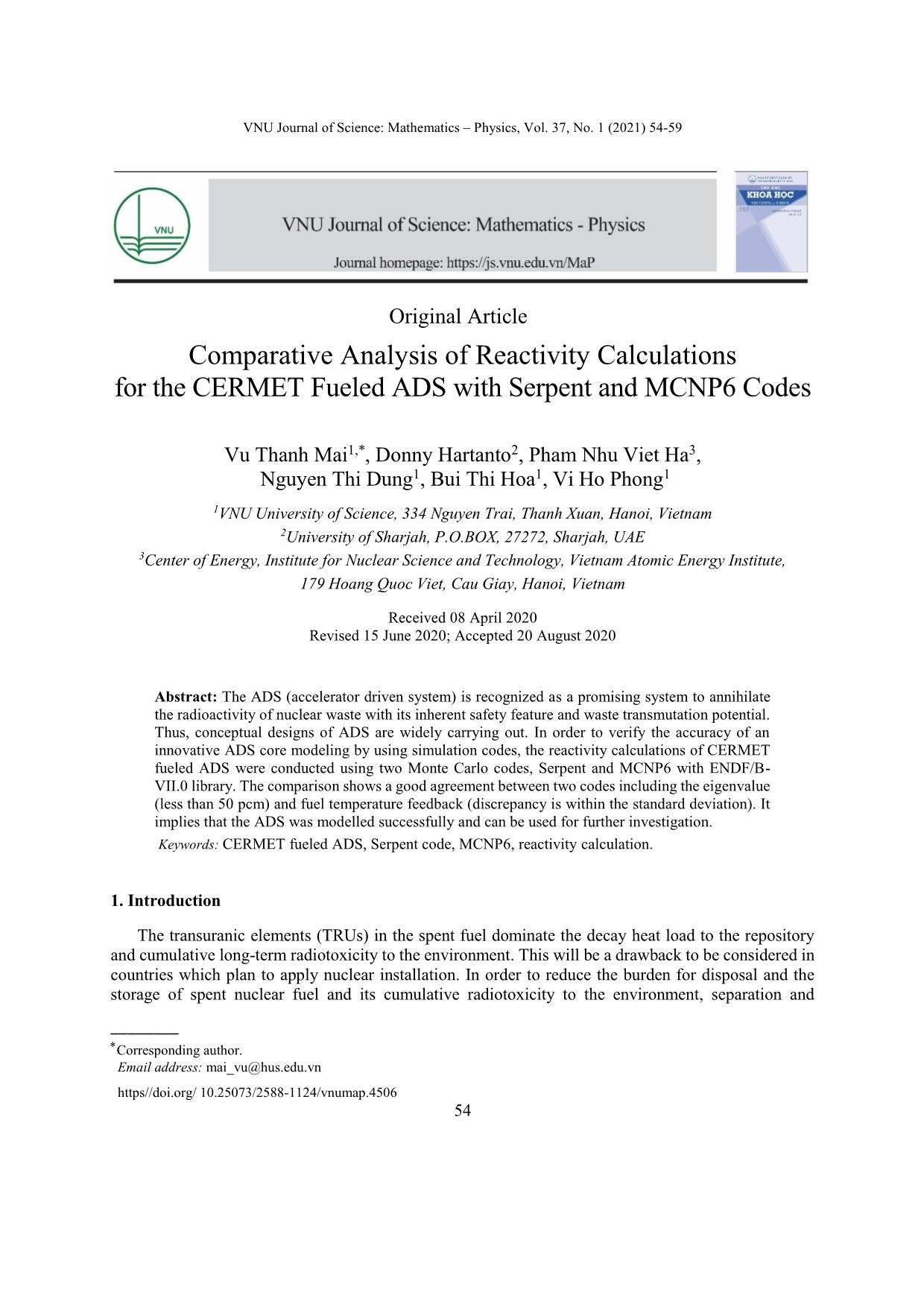
Trang 1
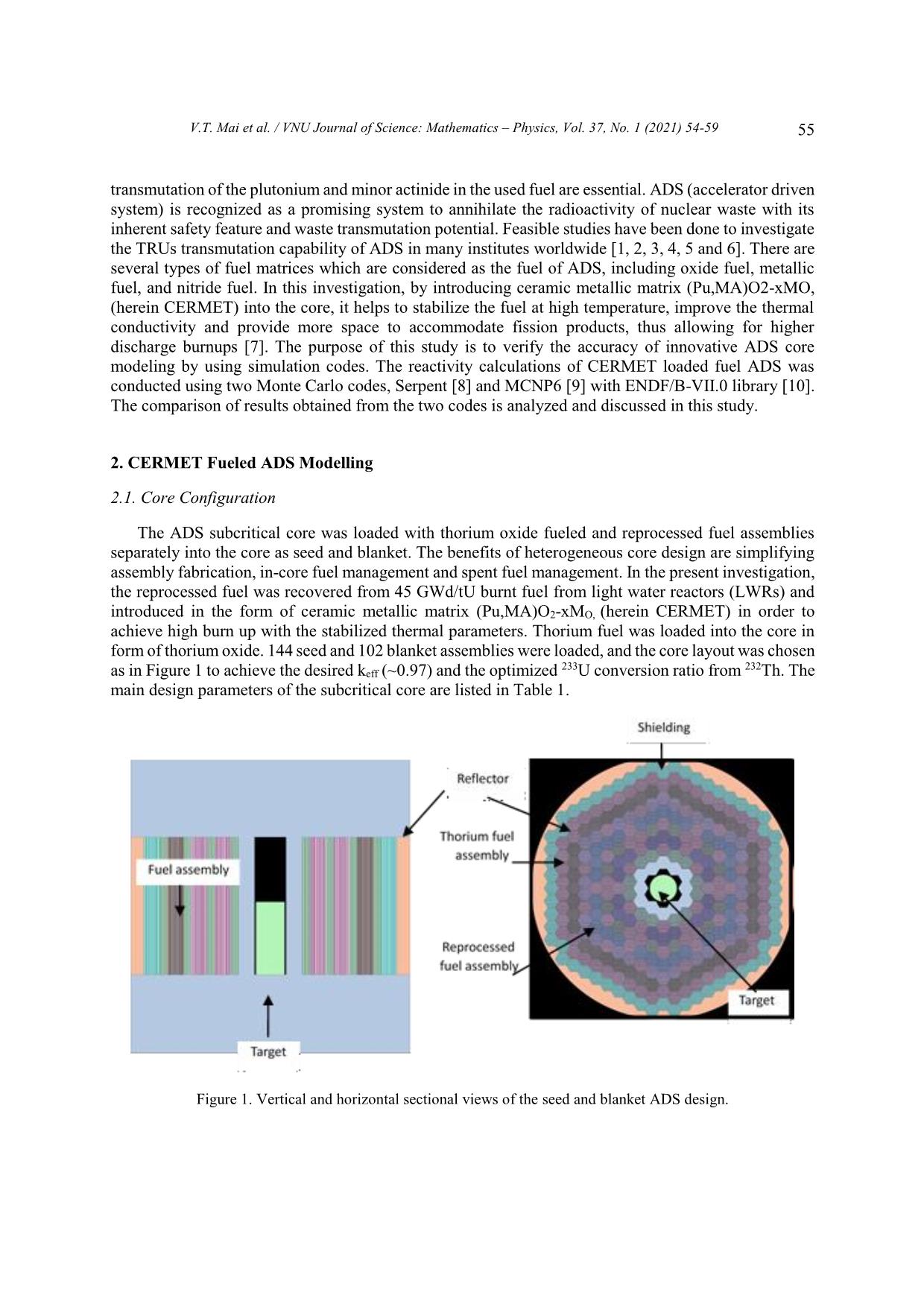
Trang 2
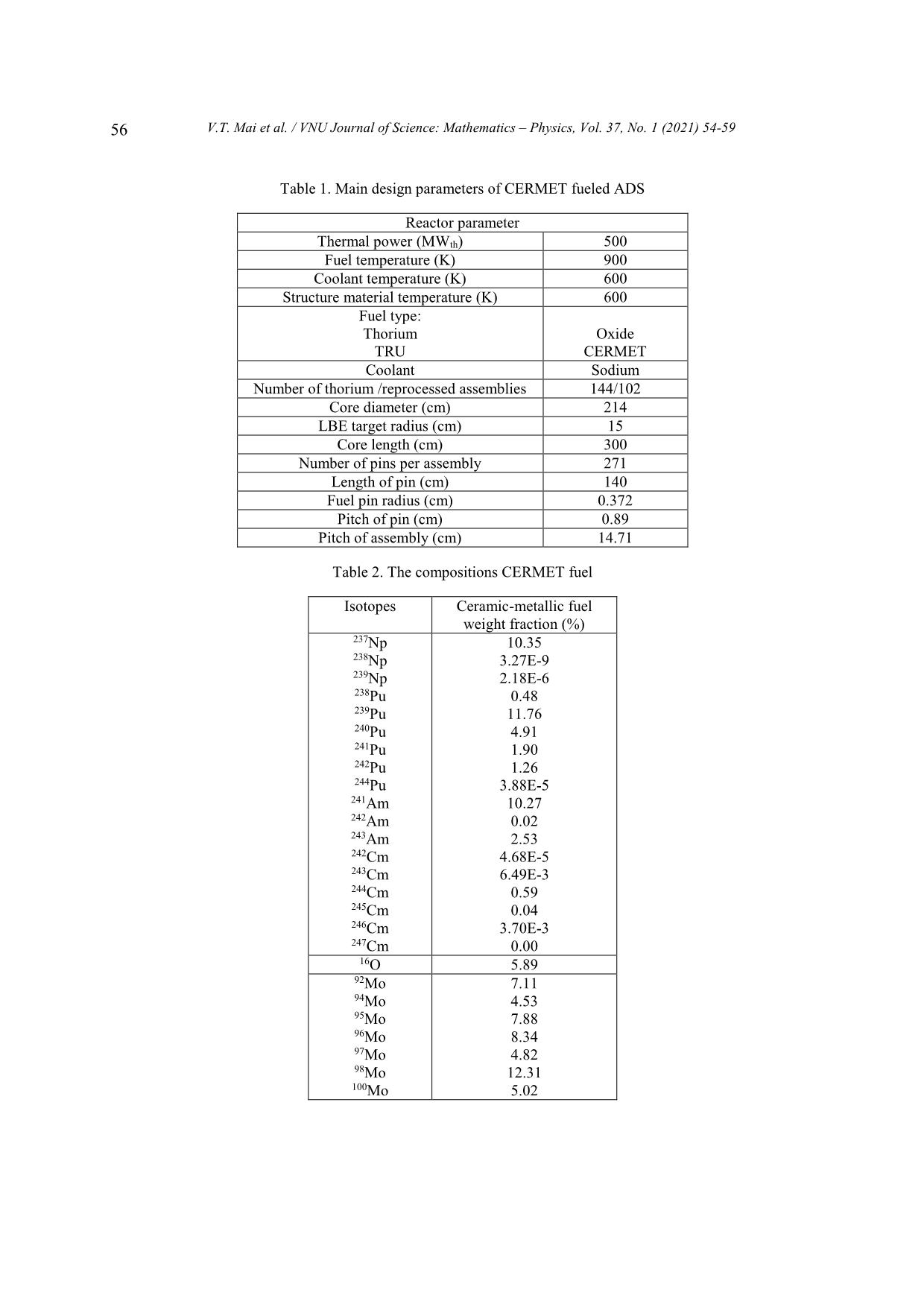
Trang 3
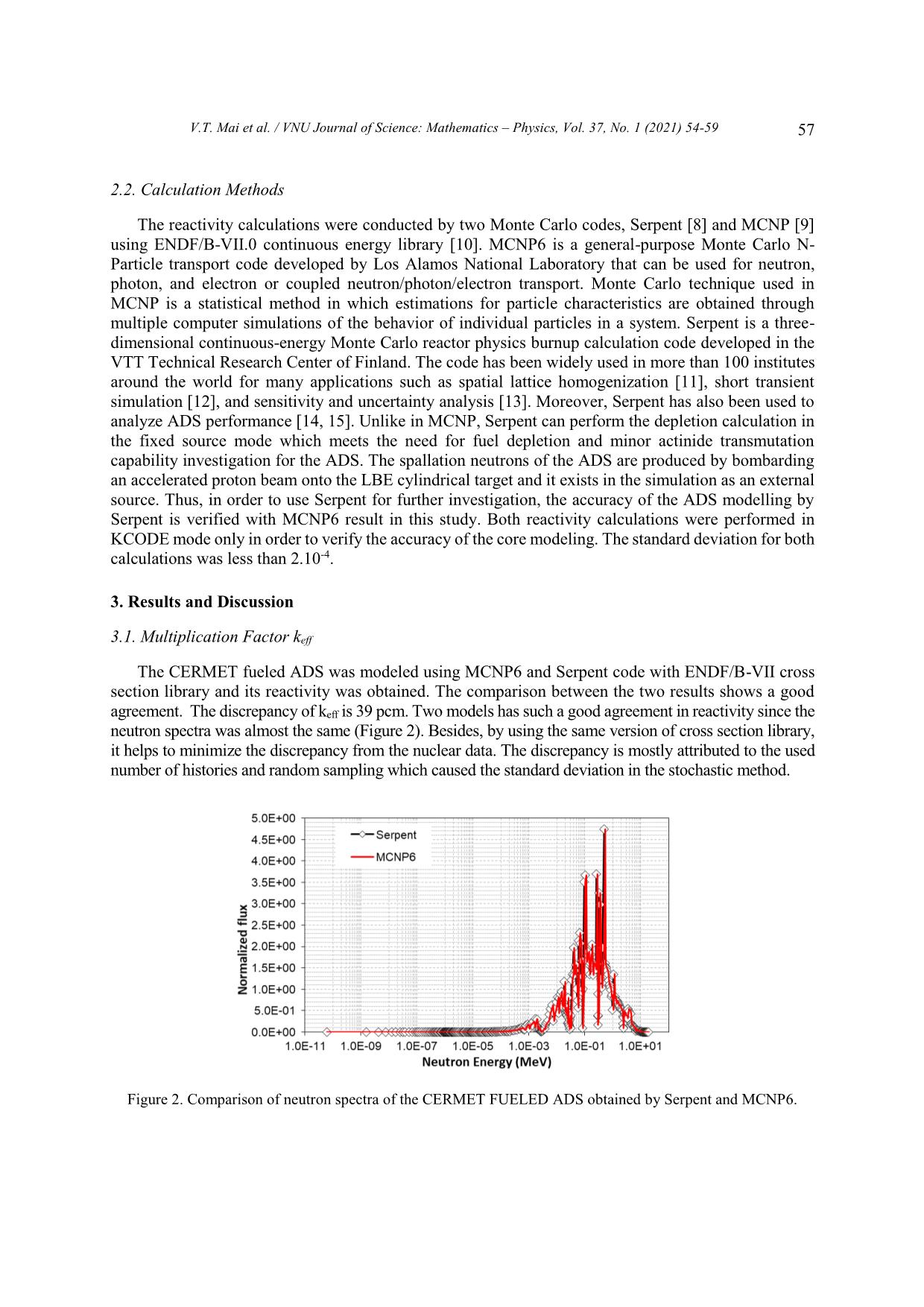
Trang 4
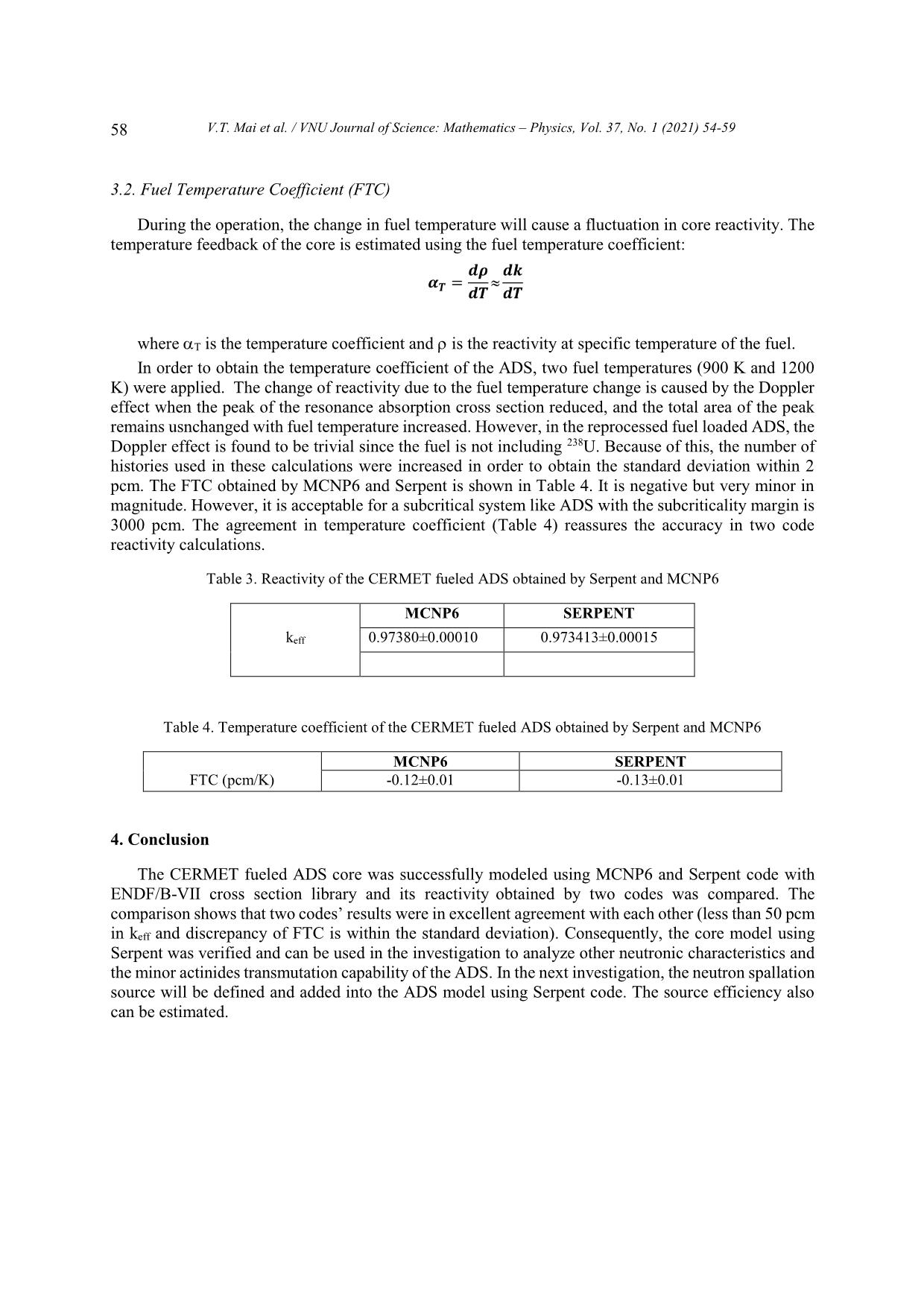
Trang 5
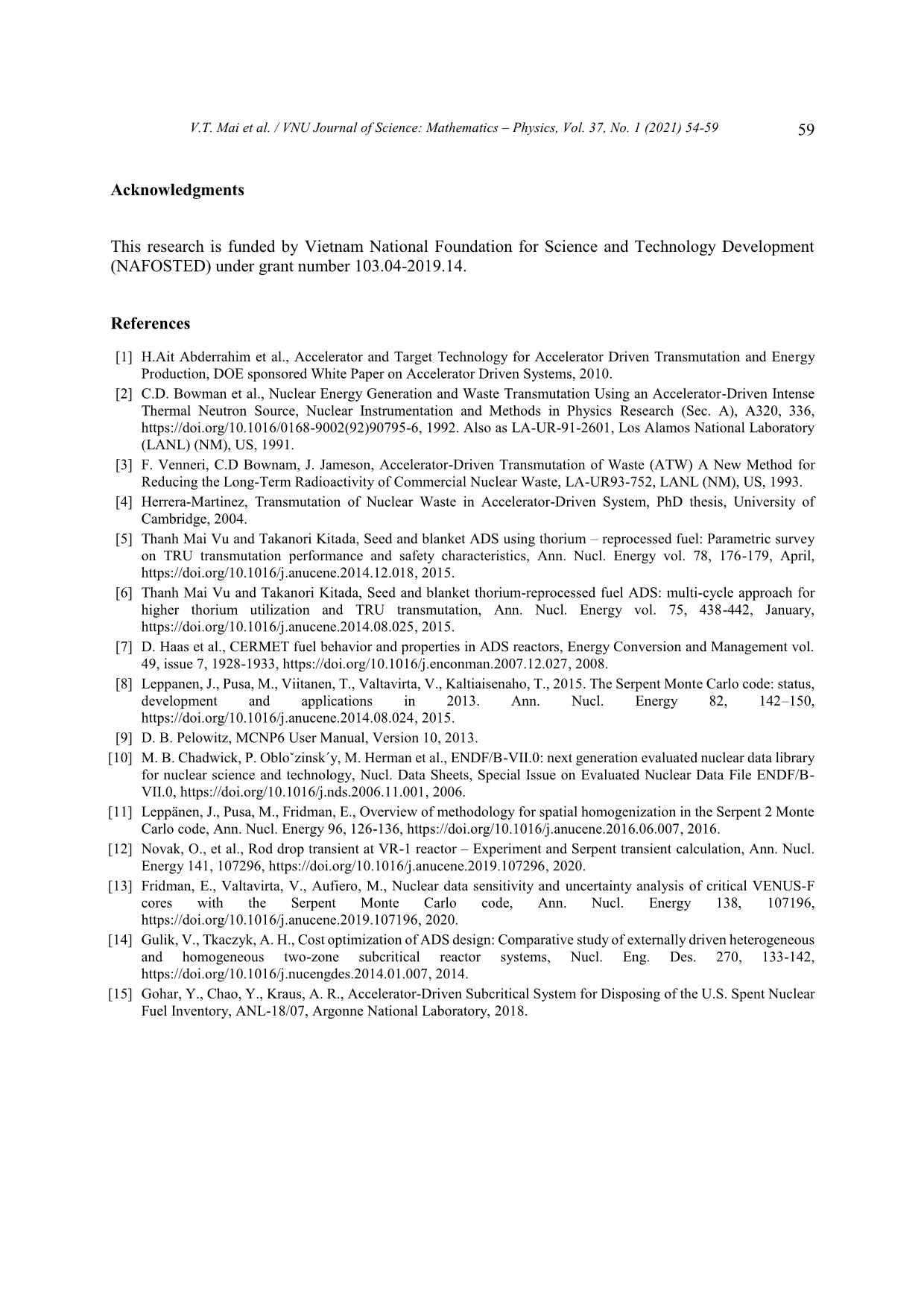
Trang 6
Tóm tắt nội dung tài liệu: Comparative Analysis of Reactivity Calculations for the CERMET Fueled ADS with Serpent and MCNP6 Codes

VNU Journal of Science: Mathematics – Physics, Vol. 37, No. 1 (2021) 54-59 Original Article Comparative Analysis of Reactivity Calculations for the CERMET Fueled ADS with Serpent and MCNP6 Codes Vu Thanh Mai1,*, Donny Hartanto2, Pham Nhu Viet Ha3, Nguyen Thi Dung1, Bui Thi Hoa1, Vi Ho Phong1 1VNU University of Science, 334 Nguyen Trai, Thanh Xuan, Hanoi, Vietnam 2University of Sharjah, P.O.BOX, 27272, Sharjah, UAE 3Center of Energy, Institute for Nuclear Science and Technology, Vietnam Atomic Energy Institute, 179 Hoang Quoc Viet, Cau Giay, Hanoi, Vietnam Received 08 April 2020 Revised 15 June 2020; Accepted 20 August 2020 Abstract: The ADS (accelerator driven system) is recognized as a promising system to annihilate the radioactivity of nuclear waste with its inherent safety feature and waste transmutation potential. Thus, conceptual designs of ADS are widely carrying out. In order to verify the accuracy of an innovative ADS core modeling by using simulation codes, the reactivity calculations of CERMET fueled ADS were conducted using two Monte Carlo codes, Serpent and MCNP6 with ENDF/B- VII.0 library. The comparison shows a good agreement between two codes including the eigenvalue (less than 50 pcm) and fuel temperature feedback (discrepancy is within the standard deviation). It implies that the ADS was modelled successfully and can be used for further investigation. Keywords: CERMET fueled ADS, Serpent code, MCNP6, reactivity calculation. 1. Introduction The transuranic elements (TRUs) in the spent fuel dominate the decay heat load to the repository and cumulative long-term radiotoxicity to the environment. This will be a drawback to be considered in countries which plan to apply nuclear installation. In order to reduce the burden for disposal and the storage of spent nuclear fuel and its cumulative radiotoxicity to the environment, separation and ________ Corresponding author. Email address: mai_vu@hus.edu.vn https//doi.org/ 10.25073/2588-1124/vnumap.4506 54 V.T. Mai et al. / VNU Journal of Science: Mathematics – Physics, Vol. 37, No. 1 (2021) 54-59 55 transmutation of the plutonium and minor actinide in the used fuel are essential. ADS (accelerator driven system) is recognized as a promising system to annihilate the radioactivity of nuclear waste with its inherent safety feature and waste transmutation potential. Feasible studies have been done to investigate the TRUs transmutation capability of ADS in many institutes worldwide [1, 2, 3, 4, 5 and 6]. There are several types of fuel matrices which are considered as the fuel of ADS, including oxide fuel, metallic fuel, and nitride fuel. In this investigation, by introducing ceramic metallic matrix (Pu,MA)O2-xMO, (herein CERMET) into the core, it helps to stabilize the fuel at high temperature, improve the thermal conductivity and provide more space to accommodate fission products, thus allowing for higher discharge burnups [7]. The purpose of this study is to verify the accuracy of innovative ADS core modeling by using simulation codes. The reactivity calculations of CERMET loaded fuel ADS was conducted using two Monte Carlo codes, Serpent [8] and MCNP6 [9] with ENDF/B-VII.0 library [10]. The comparison of results obtained from the two codes is analyzed and discussed in this study. 2. CERMET Fueled ADS Modelling 2.1. Core Configuration The ADS subcritical core was loaded with thorium oxide fueled and reprocessed fuel assemblies separately into the core as seed and blanket. The benefits of heterogeneous core design are simplifying assembly fabrication, in-core fuel management and spent fuel management. In the present investigation, the reprocessed fuel was recovered from 45 GWd/tU burnt fuel from light water reactors (LWRs) and introduced in the form of ceramic metallic matrix (Pu,MA)O2-xMO, (herein CERMET) in order to achieve high burn up with the stabilized thermal parameters. Thorium fuel was loaded into the core in form of thorium oxide. 144 seed and 102 blanket assemblies were loaded, and the core layout was chosen 233 232 as in Figure 1 to achieve the desired keff (~0.97) and the optimized U conversion ratio from Th. The main design parameters of the subcritical core are listed in Table 1. Figure 1. Vertical and horizontal sectional views of the seed and blanket ADS design. 56 V.T. Mai et al. / VNU Journal of Science: Mathematics – Physics, Vol. 37, No. 1 (2021) 54-59 Table 1. Main design parameters of CERMET fueled ADS Reactor parameter Thermal power (MWth) 500 Fuel temperature (K) 900 Coolant temperature (K) 600 Structure material temperature (K) 600 Fuel type: Thorium Oxide TRU CERMET Coolant Sodium Number of thorium /reprocessed assemblies 144/102 Core diameter (cm) 214 LBE target radius (cm) 15 Core length (cm) 300 Number of pins per assembly 271 Length of pin (cm) 140 Fuel pin radius (cm) 0.372 Pitch of pin (cm) 0.89 Pitch of assembly (cm) 14.71 Table 2. The compositions CERMET fuel Isotopes Ceramic-metallic fuel weight fraction (%) 237Np 10.35 238Np 3.27E-9 239Np 2.18E-6 238Pu 0.48 239Pu 11.76 240Pu 4.91 241Pu 1.90 242Pu 1.26 244Pu 3.88E-5 241Am 10.27 242Am 0.02 243Am 2.53 242Cm 4.68E-5 243Cm 6.49E-3 244Cm 0.59 245Cm 0.04 246Cm 3.70E-3 247Cm 0.00 16O 5.89 92Mo 7.11 94Mo 4.53 95Mo 7.88 96Mo 8.34 97Mo 4.82 98Mo 12.31 100Mo 5.02 V.T. Mai et al. / VNU Journal of Science: Mathematics – Physics, Vol. 37, No. 1 (2021) 54-59 57 2.2. Calculation Methods The reactivity calculations were conducted by two Monte Carlo codes, Serpent [8] and MCNP [9] using ENDF/B-VII.0 continuous energy library [10]. MCNP6 is a general-purpose Monte Carlo N- Particle transport code developed by Los Alamos National Laboratory that can be used for neutron, photon, and electron or coupled neutron/photon/electron transport. Monte Carlo technique used in MCNP is a statistical method in which estimations for particle characteristics are obtained through multiple computer simulations of the behavior of individual particles in a system. Serpent is a three- dimensional continuous-energy Monte Carlo reactor physics burnup calculation code developed in the VTT Technical Research Center of Finland. The code has been widely used in more than 100 institutes around the world for many applications such as spatial lattice homogenization [11], short transient simulation [12], and sensitivity and uncertainty analysis [13]. Moreover, Serpent has also been used to analyze ADS performance [14, 15]. Unlike in MCNP, Serpent can perform the depletion calculation in the fixed source mode which meets the need for fuel depletion and minor actinide transmutation capability investigation for the ADS. The spallation neutrons of the ADS are produced by bombarding an accelerated proton beam onto the LBE cylindrical target and it exists in the simulation as an external source. Thus, in order to use Serpent for further investigation, the accuracy of the ADS modelling by Serpent is verified with MCNP6 result in this study. Both reactivity calculations were performed in KCODE mode only in order to verify the accuracy of the core modeling. The standard deviation for both calculations was less than 2.10-4. 3. Results and Discussion 3.1. Multiplication Factor keff The CERMET fueled ADS was modeled using MCNP6 and Serpent code with ENDF/B-VII cross section library and its reactivity was obtained. The comparison between the two results shows a good agreement. The discrepancy of keff is 39 pcm. Two models has such a good agreement in reactivity since the neutron spectra was almost the same (Figure 2). Besides, by using the same version of cross section library, it helps to minimize the discrepancy from the nuclear data. The discrepancy is mostly attributed to the used number of histories and random sampling which caused the standard deviation in the stochastic method. Figure 2. Comparison of neutron spectra of the CERMET FUELED ADS obtained by Serpent and MCNP6. 58 V.T. Mai et al. / VNU Journal of Science: Mathematics – Physics, Vol. 37, No. 1 (2021) 54-59 3.2. Fuel Temperature Coefficient (FTC) During the operation, the change in fuel temperature will cause a fluctuation in core reactivity. The temperature feedback of the core is estimated using the fuel temperature coefficient: where T is the temperature coefficient and is the reactivity at specific temperature of the fuel. In order to obtain the temperature coefficient of the ADS, two fuel temperatures (900 K and 1200 K) were applied. The change of reactivity due to the fuel temperature change is caused by the Doppler effect when the peak of the resonance absorption cross section reduced, and the total area of the peak remains usnchanged with fuel temperature increased. However, in the reprocessed fuel loaded ADS, the Doppler effect is found to be trivial since the fuel is not including 238U. Because of this, the number of histories used in these calculations were increased in order to obtain the standard deviation within 2 pcm. The FTC obtained by MCNP6 and Serpent is shown in Table 4. It is negative but very minor in magnitude. However, it is acceptable for a subcritical system like ADS with the subcriticality margin is 3000 pcm. The agreement in temperature coefficient (Table 4) reassures the accuracy in two code reactivity calculations. Table 3. Reactivity of the CERMET fueled ADS obtained by Serpent and MCNP6 MCNP6 SERPENT keff 0.97380±0.00010 0.973413±0.00015 Table 4. Temperature coefficient of the CERMET fueled ADS obtained by Serpent and MCNP6 MCNP6 SERPENT FTC (pcm/K) -0.12±0.01 -0.13±0.01 4. Conclusion The CERMET fueled ADS core was successfully modeled using MCNP6 and Serpent code with ENDF/B-VII cross section library and its reactivity obtained by two codes was compared. The comparison shows that two codes’ results were in excellent agreement with each other (less than 50 pcm in keff and discrepancy of FTC is within the standard deviation). Consequently, the core model using Serpent was verified and can be used in the investigation to analyze other neutronic characteristics and the minor actinides transmutation capability of the ADS. In the next investigation, the neutron spallation source will be defined and added into the ADS model using Serpent code. The source efficiency also can be estimated. V.T. Mai et al. / VNU Journal of Science: Mathematics – Physics, Vol. 37, No. 1 (2021) 54-59 59 Acknowledgments This research is funded by Vietnam National Foundation for Science and Technology Development (NAFOSTED) under grant number 103.04-2019.14. References [1] H.Ait Abderrahim et al., Accelerator and Target Technology for Accelerator Driven Transmutation and Energy Production, DOE sponsored White Paper on Accelerator Driven Systems, 2010. [2] C.D. Bowman et al., Nuclear Energy Generation and Waste Transmutation Using an Accelerator-Driven Intense Thermal Neutron Source, Nuclear Instrumentation and Methods in Physics Research (Sec. A), A320, 336, https://doi.org/10.1016/0168-9002(92)90795-6, 1992. Also as LA-UR-91-2601, Los Alamos National Laboratory (LANL) (NM), US, 1991. [3] F. Venneri, C.D Bownam, J. Jameson, Accelerator-Driven Transmutation of Waste (ATW) A New Method for Reducing the Long-Term Radioactivity of Commercial Nuclear Waste, LA-UR93-752, LANL (NM), US, 1993. [4] Herrera-Martinez, Transmutation of Nuclear Waste in Accelerator-Driven System, PhD thesis, University of Cambridge, 2004. [5] Thanh Mai Vu and Takanori Kitada, Seed and blanket ADS using thorium – reprocessed fuel: Parametric survey on TRU transmutation performance and safety characteristics, Ann. Nucl. Energy vol. 78, 176-179, April, https://doi.org/10.1016/j.anucene.2014.12.018, 2015. [6] Thanh Mai Vu and Takanori Kitada, Seed and blanket thorium-reprocessed fuel ADS: multi-cycle approach for higher thorium utilization and TRU transmutation, Ann. Nucl. Energy vol. 75, 438-442, January, https://doi.org/10.1016/j.anucene.2014.08.025, 2015. [7] D. Haas et al., CERMET fuel behavior and properties in ADS reactors, Energy Conversion and Management vol. 49, issue 7, 1928-1933, https://doi.org/10.1016/j.enconman.2007.12.027, 2008. [8] Leppanen, J., Pusa, M., Viitanen, T., Valtavirta, V., Kaltiaisenaho, T., 2015. The Serpent Monte Carlo code: status, development and applications in 2013. Ann. Nucl. Energy 82, 142–150, https://doi.org/10.1016/j.anucene.2014.08.024, 2015. [9] D. B. Pelowitz, MCNP6 User Manual, Version 10, 2013. [10] M. B. Chadwick, P. Obloˇzinsk´y, M. Herman et al., ENDF/B-VII.0: next generation evaluated nuclear data library for nuclear science and technology, Nucl. Data Sheets, Special Issue on Evaluated Nuclear Data File ENDF/B- VII.0, https://doi.org/10.1016/j.nds.2006.11.001, 2006. [11] Leppänen, J., Pusa, M., Fridman, E., Overview of methodology for spatial homogenization in the Serpent 2 Monte Carlo code, Ann. Nucl. Energy 96, 126-136, https://doi.org/10.1016/j.anucene.2016.06.007, 2016. [12] Novak, O., et al., Rod drop transient at VR-1 reactor – Experiment and Serpent transient calculation, Ann. Nucl. Energy 141, 107296, https://doi.org/10.1016/j.anucene.2019.107296, 2020. [13] Fridman, E., Valtavirta, V., Aufiero, M., Nuclear data sensitivity and uncertainty analysis of critical VENUS-F cores with the Serpent Monte Carlo code, Ann. Nucl. Energy 138, 107196, https://doi.org/10.1016/j.anucene.2019.107196, 2020. [14] Gulik, V., Tkaczyk, A. H., Cost optimization of ADS design: Comparative study of externally driven heterogeneous and homogeneous two-zone subcritical reactor systems, Nucl. Eng. Des. 270, 133-142, https://doi.org/10.1016/j.nucengdes.2014.01.007, 2014. [15] Gohar, Y., Chao, Y., Kraus, A. R., Accelerator-Driven Subcritical System for Disposing of the U.S. Spent Nuclear Fuel Inventory, ANL-18/07, Argonne National Laboratory, 2018.
File đính kèm:
 comparative_analysis_of_reactivity_calculations_for_the_cerm.pdf
comparative_analysis_of_reactivity_calculations_for_the_cerm.pdf

